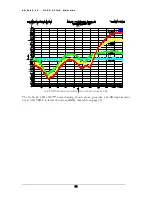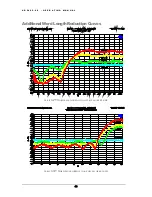
A D 2 4 0 2 - 9 6 - O P E R A T I N G M A N U A L
does not have enough self-noise to provide adequate dither for truncation to 20-bits (nor 16-
bits). For this reason it is imperative to use one of the 20-bit output settings when feeding
20-bit devices, and one of the 16-bit settings when feeding 16-bit devices. Remember that
truncation without adequate dither will cause distortion.
One additional caution concerning truncation: Each world length reduction process requires
a new source of dither noise. For example, consider a signal starts out at 24-bits and is
dithered down 16-bits. Lets suppose we take this 16-bit signal and feed it into a 24-bit digital
audio workstation, and apply a minor gain change or a touch of EQ. This 16-bit signal has
now become a 24-bit signal inside the workstation. If the final product is going to be 16-
bits, a second 24 to 16-bit word length reduction process must be applied. Some have
assumed that it is not necessary to add dither in the second process because it was already
added in the first process. However, truncation to 16-bits at the output of the workstation
will add distortion to the audio. Instead, use the digital to digital word length reduction
feature in the AD2402-96 to reduce the word length back to 16-bits. Remember every word
length reduction process requires a new source of dither noise.
Digital Word Length Increases when a Signal is Processed:
Every time a digital signal is processed, its word length increases. "Processing" includes even
simple operations such as level changes and the mixing of two signals. Word lengths expand
dramatically when more complex operations such as equalization, sample rate conversion,
and effects processing are applied. Long word lengths created by digital signal processing
must be shortened before they can be re-recorded or sent to a DAC for monitoring.
Every time a digital word length is shortened, a new source of noise must be added to the
signal prior to truncation. Dither noise that was applied for one truncation operation is not
useful for dithering a subsequent truncation operation. Failure to add a new source of noise
prior to each truncation process will create distortion. The self-noise of an A/D converter,
the noise of the mic-pre, and ambient noise. Again, every word length reduction process
requires a new source of dither noise.
Additional Information
An article on dither and a web audio demonstration by Christopher M. Hicks of the effects
of three forms of word length reduction can be found at
http://www.mtsu.edu/~dsmitche/rim420/reading/rim420_Dither.html
Demonstrated are; rounding, TPDF dither and simple noise shaped dither. This is an
excellent and graphic demonstration of these issues.
Another educational overview of digital audio and dither by Christopher M. Hicks may be
accessed at
http://www.benchmarkmedia.com/appnotes-d/hicks1994.htm
A more in depth
educational paper by Mr. Hicks in PDF form is found at
http://www.benchmarkmedia.com/appnotes-d/ditherap.pdf
41








































